Effect of Urban Heat Island and Global Warming Countermeasures on Heat Release and Carbon Dioxide Emissions from a Detached House
Abstract
1. Introduction
2. Methods
2.1. Simulation Model
2.2. Building and Weather Condition
2.3. Countermeasures
3. Results
3.1. Base Condition (No Countermeasure)
3.2. Variation of the Heat Release by Applying Countermeasures
3.2.1. Envelope Surface
3.2.2. Space Conditioning System
3.2.3. Water Heater System
3.3. Performance Evaluation Concerning the Heat Release and Carbon Dioxide Emissions
3.3.1. Cooling Season
3.3.2. Heating Season
4. Discussion
5. Conclusions
- (1)
- We constructed the SCIENCE-Outdoor model for evaluating UHIE countermeasures and GW countermeasures. This model can evaluate the thermal condition of building envelope surfaces, both inside and outside, and consists of the three submodels: (a) radiant, (b) inside thermal environment, and (c) outside heat release.
- (2)
- The maximum heat release rate for a wooden detached house with a low insulation level, on a representative sunny summer day for the base condition (no countermeasures), was 180 W/m2. The breakdown of the cumulative daily heat was almost all from the envelope surface, accounting for about 87% of the total. The anthropogenic heat was very slight: space conditioning accounted for 12% and the water heating system accounted for only 1%.
- (3)
- Concerning the effectiveness of countermeasures influencing the heat from envelope surface, the reduction rate of heat release for day and nighttime was largest with roof water showering, then roof greening, and then high-albedo roof in the cooling season.
- (4)
- Concerning the effectiveness of countermeasures influencing the heat from space conditioning, the reduction rate for day and nighttime was largest with roof greening, then roof water showering, then evaporative space cooling, and then high-albedo roof in the cooling season. In the heating season, the amount of absorbed heat through the space conditioning increased slightly under the high-albedo roof countermeasure.
- (5)
- The effectiveness of countermeasures influencing the heat from the water heating system decreased for heat pump water heaters and condensing water heaters but increased for gas engine cogeneration systems and solid oxide fuel cells in the cooling season. During the heating season, hot water demand rose, so water heating had a greater influence than in the cooling season.
- (6)
- As the result of evaluating the relationship between heat release reduction and CO2 emissions reduction, and by applying each countermeasure for the cooling season, the plots were roughly classified into two technology groups: those effective for heat release reduction and those effective for CO2 emissions reduction.
- (7)
- As the result of evaluating the same relationship used for the heating season, the plots were roughly classified into the same two groups as those for the cooling season, but only the heat pump water heater countermeasure was found to effect heat release reduction and CO2 emissions reduction.
- (8)
- The results showed that it is best to introduce water-using countermeasures (evaporative space cooling and roof water showering), which can provide positive effects during summer but no negative effects during winter, to plan for UHIE and GW considerations. However, since water-based countermeasures do not significantly reduce CO2 emissions, it is desirable to introduce GW countermeasures such as solid oxide fuel cell and photovoltaic power generation that substantially decrease CO2 emissions.
Author Contributions
Funding
Institutional Review Board Statement
Informed Consent Statement
Data Availability Statement
Conflicts of Interest
References
- Japan Meteorological Agency. Climate Change Monitoring Report 2016; Chapter 2 Climate Change; Japan Meteorological Agency: Tokyo, Japan, 2017. [Google Scholar]
- Japan Meteorological Agency. Global Warming Forecast Information; Global Warming Forecast Information; Japan Meteorological Agency: Tokyo, Japan, 2017; Volume 9. [Google Scholar]
- Narumi, D.; Niurao, Y.; Shimoda, Y.; Mizuno, M. Effects of increasing temperature on the regional energy consumption in Osaka Pref. J. Environ. Eng. Trans. AIJ 2007, 72, 71–78. [Google Scholar] [CrossRef]
- Santamouris, M.; Papanikolaou, N.; Livada, I.; Koronakis, I.; Georgakis, C.; Argiriou, A.; Assimakopoulos, D.N. On the impact of urban climate on the energy consuption of building. Sol. Energy 2001, 70, 201–216. [Google Scholar] [CrossRef]
- Fujii, H.; Fukuda, S.; Narumi, D.; Ihara, T.; Watanabe, Y. Fatigue and sleep under large summer temperature differences. Environ. Res. 2015, 138, 17–21. [Google Scholar] [CrossRef]
- Narumi, D.; Ihara, T.; Fukuda, S. Study on the impact for sleep disturbance due to changing urban outdoor temperature. AIJ J. Technol. Des. 2016, 52, 1045–1048. [Google Scholar] [CrossRef]
- Narumi, D.; Kondo, A.; Shimoda, Y. The effect of the increase in urban temperature on the concentration of photochemical oxidants. Atmos. Environ. 2009, 43, 2348–2359. [Google Scholar] [CrossRef]
- Sarrat, C.; Lemonsu, A.; Masson, V.; Guedalia, D. Impact of urban heat island on regional atmospheric pollution. Atmos. Environ. 2006, 40, 1743–1758. [Google Scholar] [CrossRef]
- Kiyokawa, Y.; Narumi, D. Regional and secular characteristics on temperature sensitivity of power supply. J. Environ. Eng. Trans. AIJ 2018, 83, 1015–1024. [Google Scholar] [CrossRef]
- Narumi, D.; Ihara, T.; Fukuda, S.; Shimoda, Y. Comprehensive evaluation of the influence of outdoor temperature change on human health around the urban area. J. Environ. Eng. Trans. AIJ 2019, 84, 205–214. [Google Scholar] [CrossRef]
- Shimoda, Y.; Narumi, D.; Mizuno, M. Environmental impact of urban heat island phenomena—Cause-effect chain and evaluation in Osaka City. J. Life Cycle Assess. Jpn. 2005, 1, 144–148. [Google Scholar] [CrossRef]
- Franco, G.; Sanstad, A.H. Climate change and electricity demand in California. Clim. Chang. 2008, 87, 139–151. [Google Scholar] [CrossRef]
- Hirano, Y.; Fujita, T. Evaluation of the impact of the urban heat island on residential and commercial energy consumption in Tokyo. Energy 2012, 37, 371–383. [Google Scholar] [CrossRef]
- Sailor, D.J. Relating residential and commercial sector electricity loads to climate—Evaluating state level sensitivities and vulnerabilities. Energy 2001, 26, 645–657. [Google Scholar] [CrossRef]
- Santamouris, M.; Cartalis, C.; Synnefa, A.; Kolokotsa, D. On the impact of urban heat island and global warming on the power demand and electricity consumption of buildings—A review. Energy Build. 2015, 98, 119–124. [Google Scholar] [CrossRef]
- Ashie, Y.; Tokairin, T.; Kono, T. High resolution numerical simulation on the urban heat island in a ten-kilometer square area of central Tokyo by using the earth simulator. J. Environ. Eng. Trans. AIJ 2007, 72, 67–74. [Google Scholar] [CrossRef]
- Ichinose, T.; Shimodozono, K.; Hanaki, K. Impact of anthropogenic heat on urban climate in Tokyo. Atmos. Environ. 1999, 33, 3897–3909. [Google Scholar] [CrossRef]
- Kondo, H.; Tokairin, T.; Kikegawa, Y. Calculation of wind in a Tokyo urban area with a mesoscale model including a multi-layer urban canopy model. J. Wind Eng. Ind. Aerodyn. 2008, 96, 1655–1666. [Google Scholar] [CrossRef]
- Narumi, D.; Kondo, A.; Shimoda, Y. Effects of anthropogenic heat release upon the urban climate in a Japanese megacity. Environ. Res. 2009, 109, 421–431. [Google Scholar] [CrossRef]
- Chen, F.; Dudhia, J. Coupling an advanced land surface–hydrology model with the Penn State–NCAR MM5 modeling system. Part I: Model implementation and sensitivity. Mon. Weather Rev. 2001, 129, 569–585. [Google Scholar] [CrossRef]
- Skarmaeock, W.C.; Klemp, J.B.; Dudhia, J.; Gill, D.O.; Barker, D.M.; Wang, W.; Powers, J.G. A Description of the Advanced Research WRF Version 2; NCAR Techniacal Note TN-468+STR; Defense Technical Information Center: Fort Belvoir, VA, USA, 2005; p. 88. [Google Scholar]
- Akbari, H.; Konopacki, S. Energy effects of heat-island reduction strategies in Toronto, Canada. Energy 2004, 29, 191–210. [Google Scholar] [CrossRef]
- Ohashi, Y.; Ihara, T.; Kikegawa, Y.; Sugiyama, N. Numerical simulations of influence of heat island countermeasures on outdoor human heat stress in the 23 wards of Tokyo, Japan. Energy Build. 2016, 114, 104–111. [Google Scholar] [CrossRef]
- Sailor, D.J.; Dietsch, N. The urban heat island Mitigation Impact Screening Tool (MIST). Environ. Model. Softw. 2007, 22, 1529–1541. [Google Scholar] [CrossRef]
- Santamouris, M. Cooling the cities—A review of reflective and green roof mitigation technologies to fight heat island and improve comfort in urban environments. Sol. Energy 2014, 103, 682–703. [Google Scholar] [CrossRef]
- Shimoda, Y.; Yamaguchi, Y.; Okamura, T.; Taniguchi, A.; Yamaguchi, Y. Prediction of greenhouse gas reduction potential in Japanese residential sector by residential energy end-use model. Appl. Energy 2010, 87, 1944–1952. [Google Scholar] [CrossRef]
- Iwata, T.; Kuwasawa, Y.; Murakami, S.; Ikaga, T. Study on Scenarios towards Low Carbon Society in Residential Sector. J. Environ. Eng. Trans. AIJ 2011, 76, 839–846. [Google Scholar] [CrossRef][Green Version]
- Wakiyama, T.; Kuromochi, T. Scenario analysis of energy saving and CO2 emissions reduction potentials to ratchet up Japanese mitigation target in 2030 in the residential sector. Energy Policy 2017, 103, 1–15. [Google Scholar] [CrossRef]
- Hirano, Y.; Ihara, T.; Gomi, K.; Fujita, T. Simulation-Based Evaluation of the Effect of Green Roofs in Office Building Districts on Mitigating the Urban Heat Island Effect and Reducing CO2 Emissions. Sustainability 2019, 11, 2055. [Google Scholar] [CrossRef]
- Yamaguchi, K.; Yamada, K.; Masumura, H.; Endo, Y.; Ihara, T. Evaluation for heat island mitigation potential of air source heat pump water heaters. In Proceedings of the Renewable Energy 2010 Conference and Exhibition, Berlin, Germany, 22–24 November 2010. [Google Scholar]
- Genchi, Y.; Ishisaki, M.; Ohashi, Y.; Kikegawa, Y.; Takahashi, H.; Inaba, A. Impacts of large scale photovoltaic panel installation on the heat island effect in Tokyo. In Proceedings of the 5th International Conference on Urban Climatology, Lodz, Poland, 1–5 September 2003; pp. 1–4. [Google Scholar]
- Ihara, T.; Kikegawa, Y.; Asahi, K.; Genchi, Y.; Kondo, H. Changes in year-round air temperature and annual energy consumption in office building areas by urban heat-island countermeasures and energy-saving measures. Appl. Energy 2008, 85, 12–25. [Google Scholar] [CrossRef]
- Onishi, J.; Takeya, N.; Mizuno, M. Study on numerical prediction methods for indoor air-flow and thermal environments Part 1 calculation procedures used in the simulation code “SCIENCE”. Trans. Soc. Heat. Air-Cond. Sanit. Eng. Jpn. 1995, 20, 23–34. [Google Scholar] [CrossRef]
- Habara, H.; Narumi, D.; Kobayashi, S.; Shimoda, Y.; Mizuno, M. Development of a method to estimate indoor thermal condition and air conditioning energy consumption in residential house using natural ventilation. J. Environ. Eng. Trans. AIJ 2004, 69, 107–114. [Google Scholar] [CrossRef][Green Version]
- Narumi, D.; Taketa, A.; Shimoda, Y. Development of a method to estimate indoor climate and air conditioning energy consumption in residential house considering the influence of cross ventilation. In Proceedings of the 29th Air Infiltration and Ventilation Centre Conference, Kyoto, Japan, 14–16 October 2008. [Google Scholar]
- Gebhart, B. A new method for calculating radiant exchanges. ASHRAE Trans. 1959, 65, 321–332. [Google Scholar]
- Fujii, T.; Shimoda, Y.; Morikawa, T.; Mizuno, M. Development of city scale residential energy end-use model including heat load calculation: Development and application of city scale residential energy end-use model by considering with various household categories part 1. J. Environ. Eng. Trans. AIJ 2005, 70, 51–58. [Google Scholar] [CrossRef]
- Shimoda, Y.; Okamura, T.; Yamaguchi, Y.; Yamaguchi, Y.; Taniguchi, A.; Morikawa, T. City-level energy and CO2 reduction effect by introducing new residential water heaters. Energy 2010, 35, 4880–4891. [Google Scholar] [CrossRef]
- Habara, H.; Narumi, D.; Shimoda, Y.; Mizuno, M. A study on determinants of air conditioning on/off control in dwellings based on survey. J. Environ. Eng. Trans. AIJ 2005, 70, 83–90. [Google Scholar] [CrossRef][Green Version]
- Shimoda, Y.; Fujii, T.; Morikawa, T.; Mizuno, M. Residential end-use energy simulation at city scale. Build. Environ. 2004, 39, 956–967. [Google Scholar] [CrossRef]
- Watanabe, K. Architectural Planning Principles Part 2; Maruzen: Tokyo, Japan, 1964. [Google Scholar]
- Narumi, D.; Shimoda, Y.; Habara, K.; Mizuno, M.; Kondo, A. Development of an environmental thermal load evaluation system for the purpose of mitigating urban thermal environment: Part 1: Effects of differences in environmental thermal load discharge conditions on temperature change near the ground surface. Trans. Soc. Heat. Air-Cond. Sanit. Eng. Jpn. 2006, 31, 71–78. [Google Scholar] [CrossRef]
- Ministry of the Environment & Ministry of Economy, Trade and Industry. Emission Factor for Each Electric Utility (for Calculating Total GreenHouse Gas Emissions in the Government and Local Government Action Plan)—FY2016 Results; EPA: Washington, DC, USA, 2018. [Google Scholar]
- Ministry of the Environment. Guidelines for Calculating Total Greenhouse Gas Emissions Version 1; EPA: Washington, DC, USA, 2017. [Google Scholar]
- Udagawa, M. Proposal of a standard calculation condition for a residential house. In Proceedings of the 15th Heat Transfer Symposium of AIJ, Nagoya, Japan, 28–29 November 1985; pp. 23–33. [Google Scholar]
- Architectural Institute of Japan Expanded AMeDAS Weather Data 1981–2000. Available online: https://www.metds.co.jp/product/ea/ (accessed on 14 March 2015).
- Ishida, K. Program for scheduling of indoor heat generation rate due to livelihood. In Proceedings of the SHASE Symposium, Japan, 23 October 1996. [Google Scholar]
- Global Cool Cities Alliance and R20 Regions of Climate Action. Practical Guide to Cool Roofs and Cool Pavements; CC Alliance: Washington, DC, USA, 2012. [Google Scholar]
- Castleton, H.F.; Stovin, V.; Beck, S.B.M.; Davison, J.B. Green roofs; Building energy savings and the potential for retrofit. Energy Build. 2010, 42, 1582–1591. [Google Scholar] [CrossRef]
- Matsushita, I.; Hatano, S.; Narumi, D. Evaluation on the ability of roofing unit covered with greens in mitigating outdoor thermal environment and reducing energy consumption for air-conditioning system. Pap. Environ. Inf. Sci. 2005, 19, 117–122. [Google Scholar] [CrossRef]
- Yamaguchi, T.; Yokoyama, H.; Ishii, K. Mitigating the urban heat island effect by light and thin rooftop greening. J. Jpn. Inst. Landsc. Archit. 2005, 509–512. [Google Scholar] [CrossRef]
- Narumi, D.; Shigematsu, K.; Shimoda, Y. Effect of the evaporative cooling techniques by spraying mist water on reducing urban heat flux and saving energy in an apartment house. J. Heat. Isl. Inst. Int. 2012, 7, 175–181. [Google Scholar]
- Hagishima, A.; Tanimoto, J.; Narita, K. Review of the former research on the convective heat transfer coefficient of urban surfaces. J. Jpn. Soc. Hydol. Water Resour. 2004, 17, 536–554. [Google Scholar] [CrossRef][Green Version]
- Sangiorgio, V.; Fiorito, F.; Santamouris, M. Development of a holistic urban heat island evaluation methodology. Sci. Rep. 2020, 10. [Google Scholar] [CrossRef]
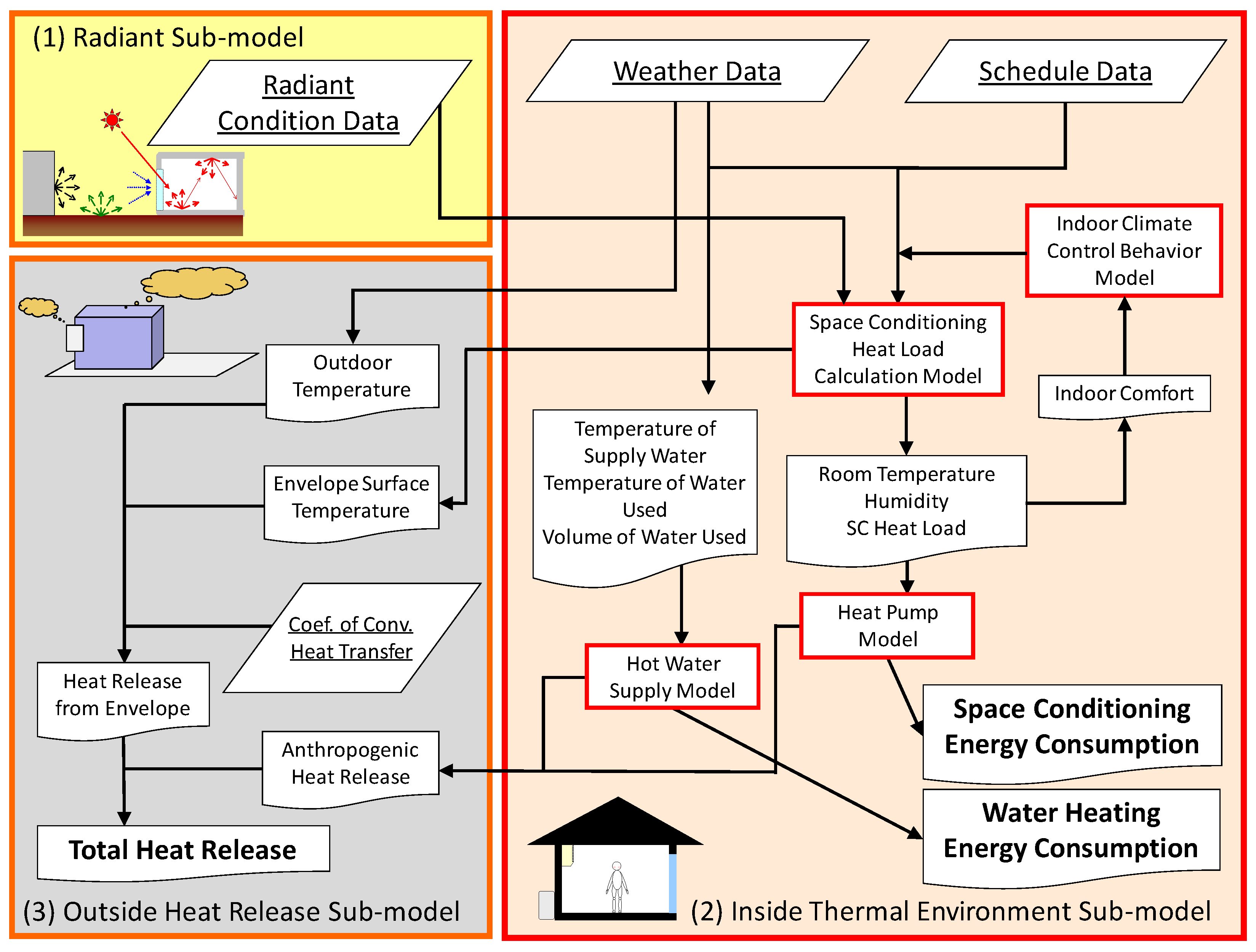

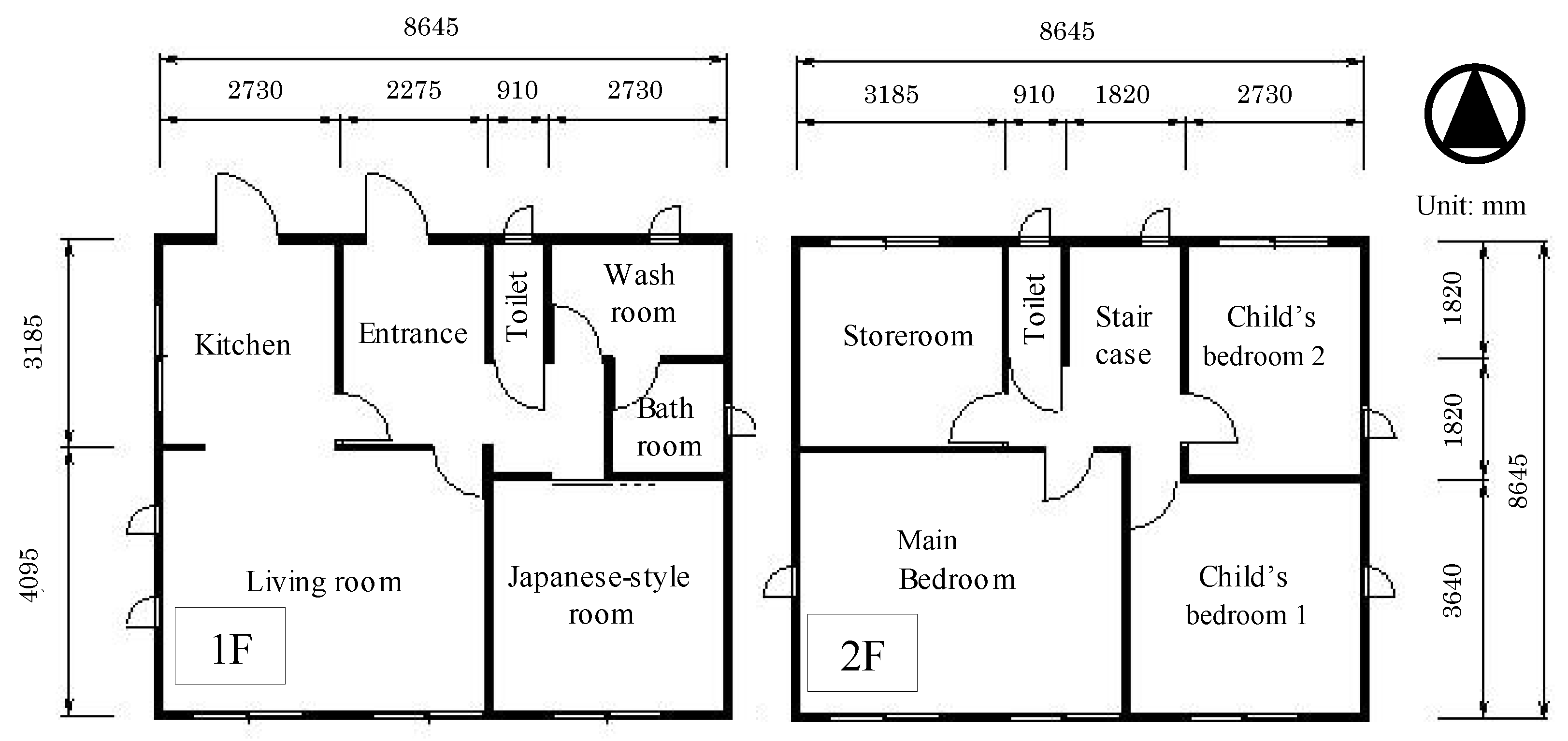
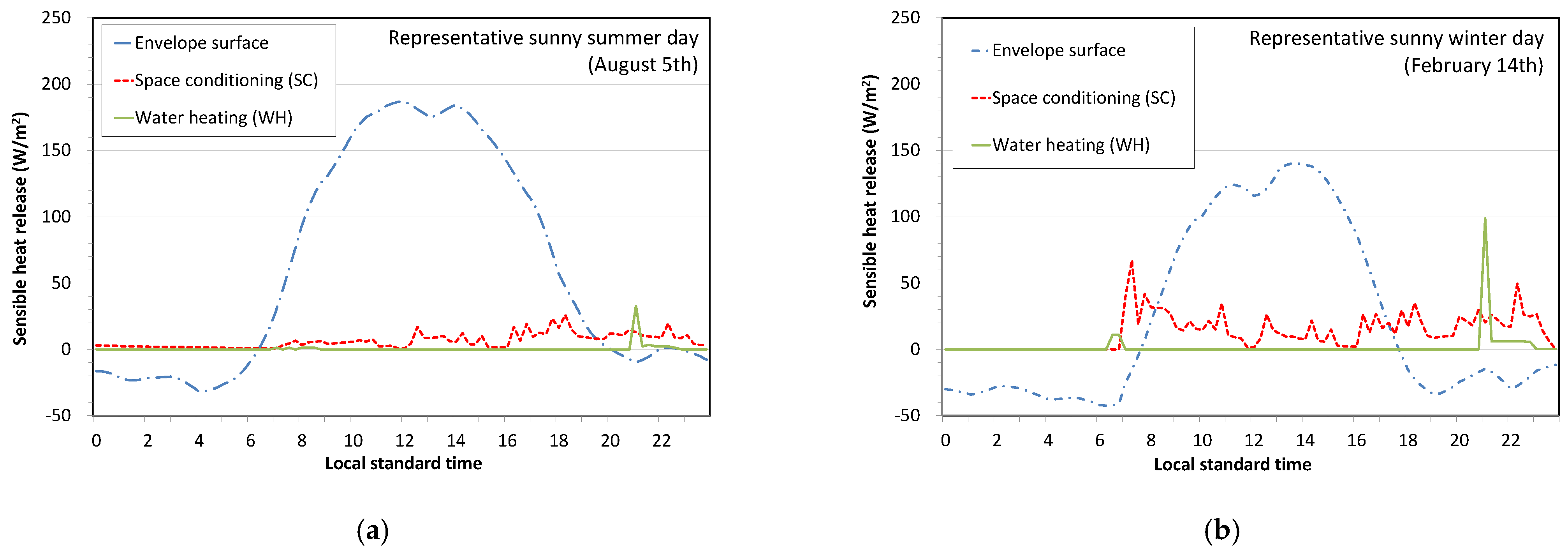
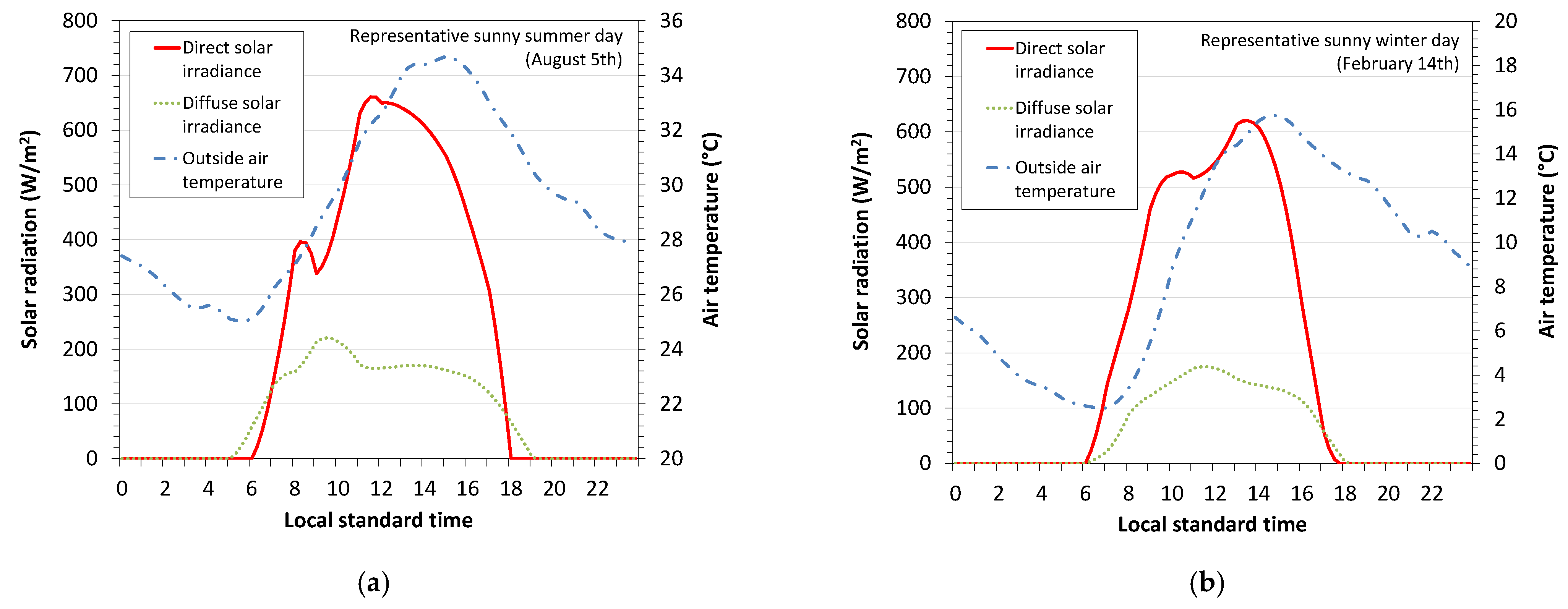
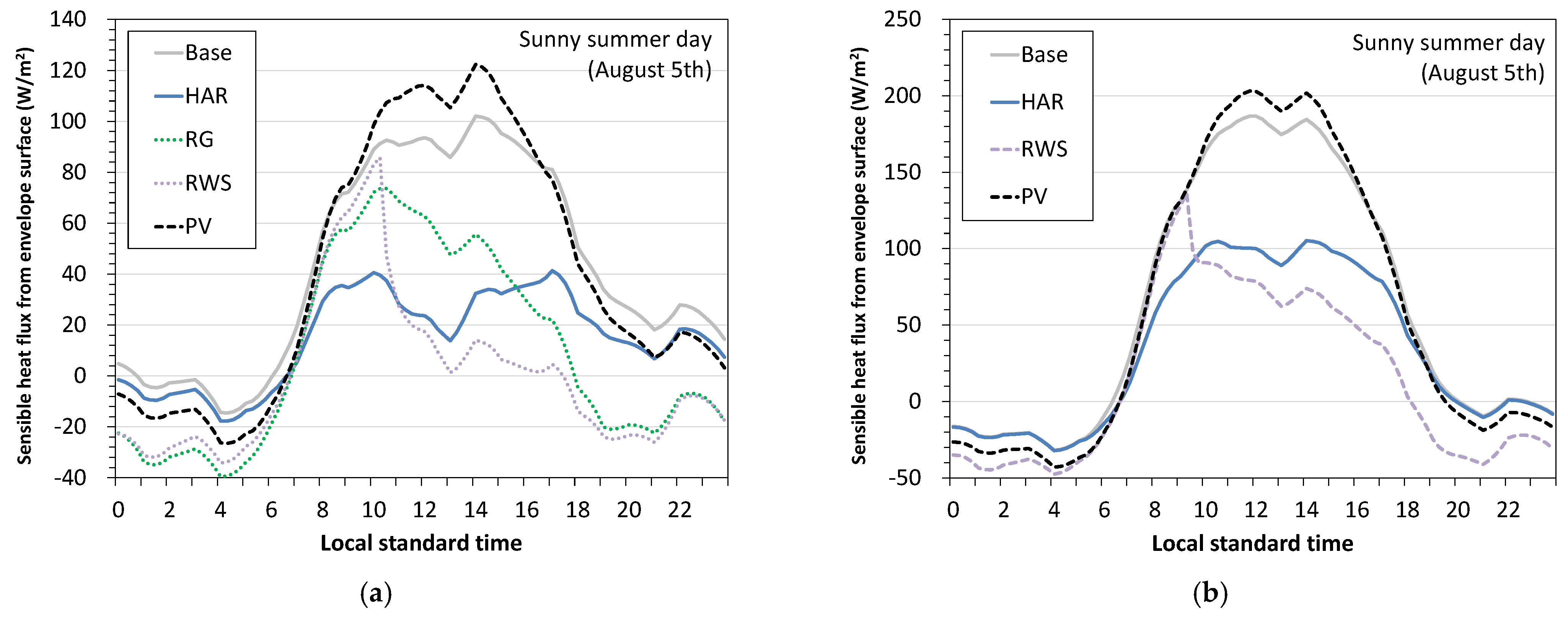
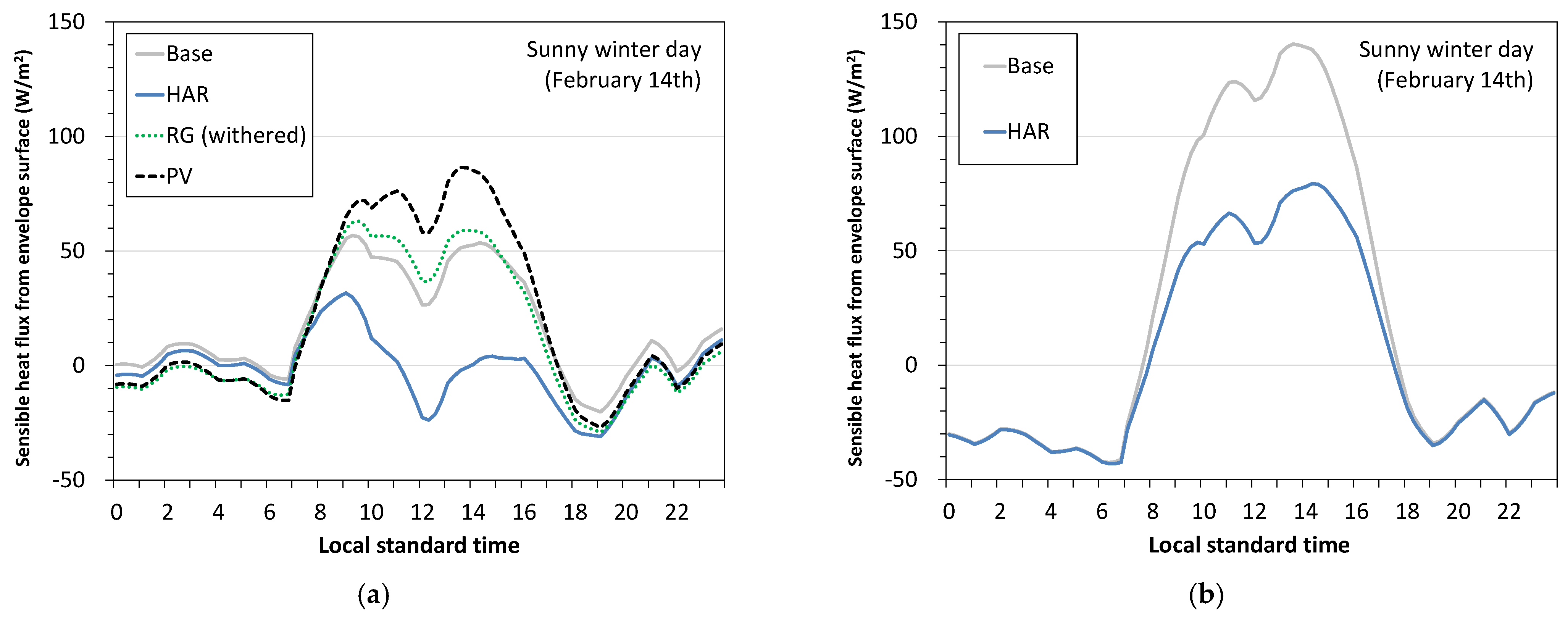
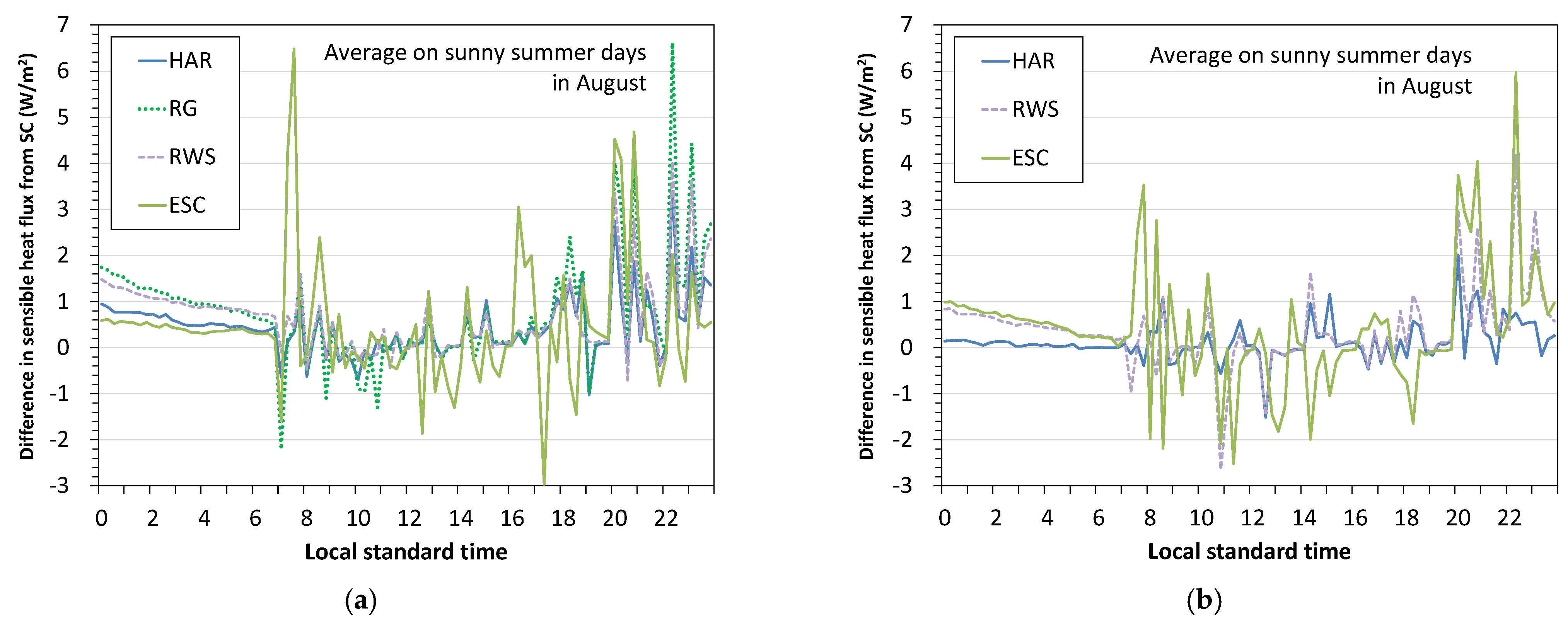

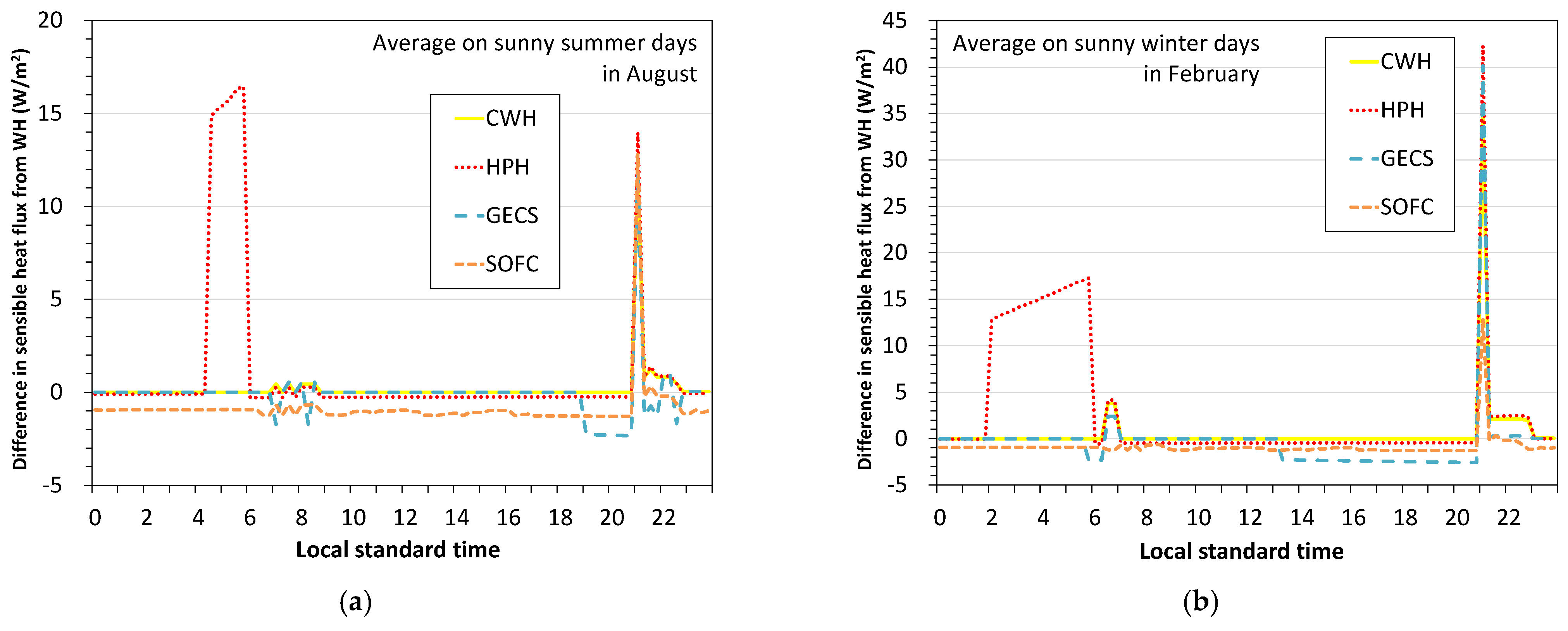
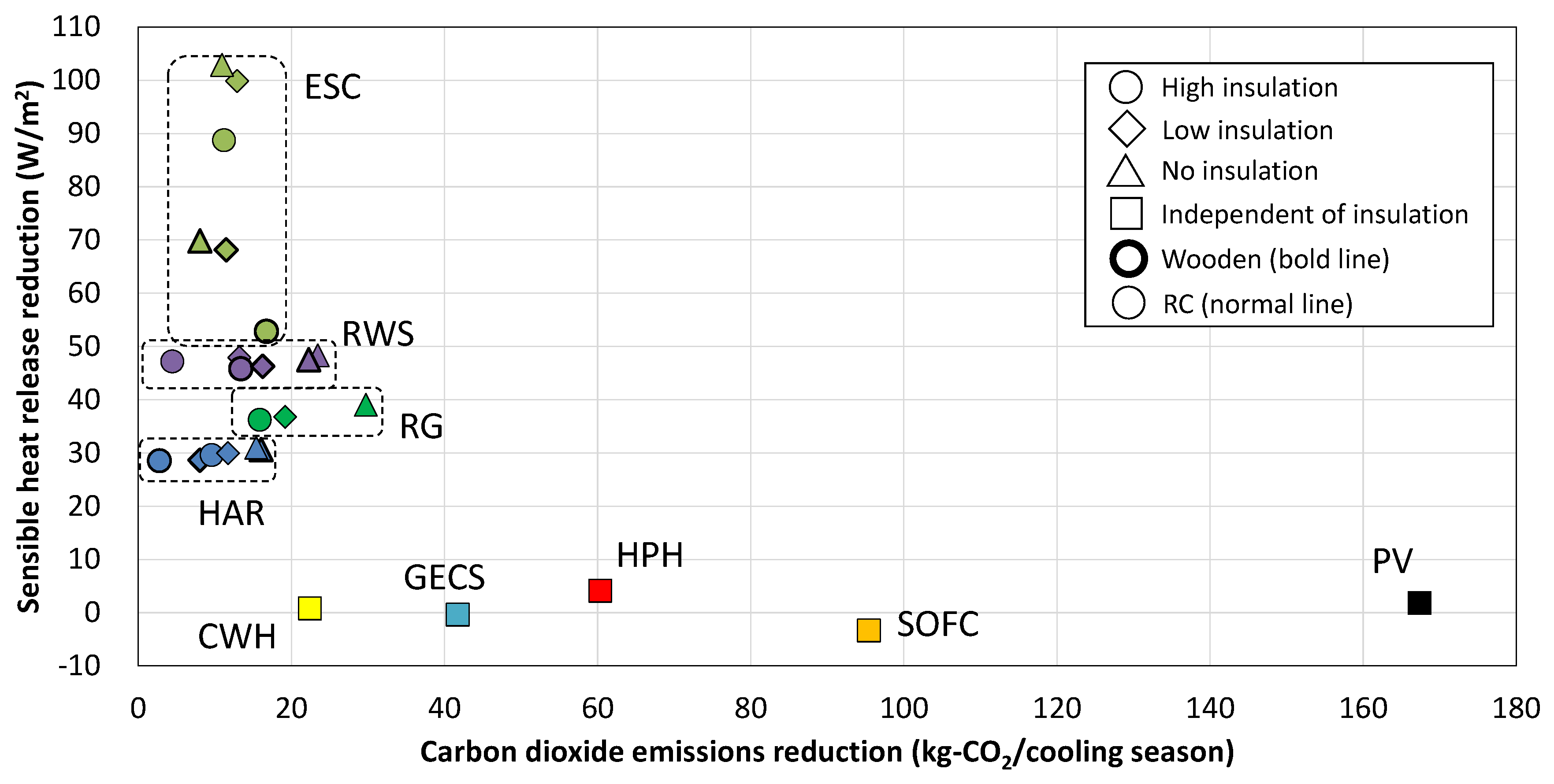
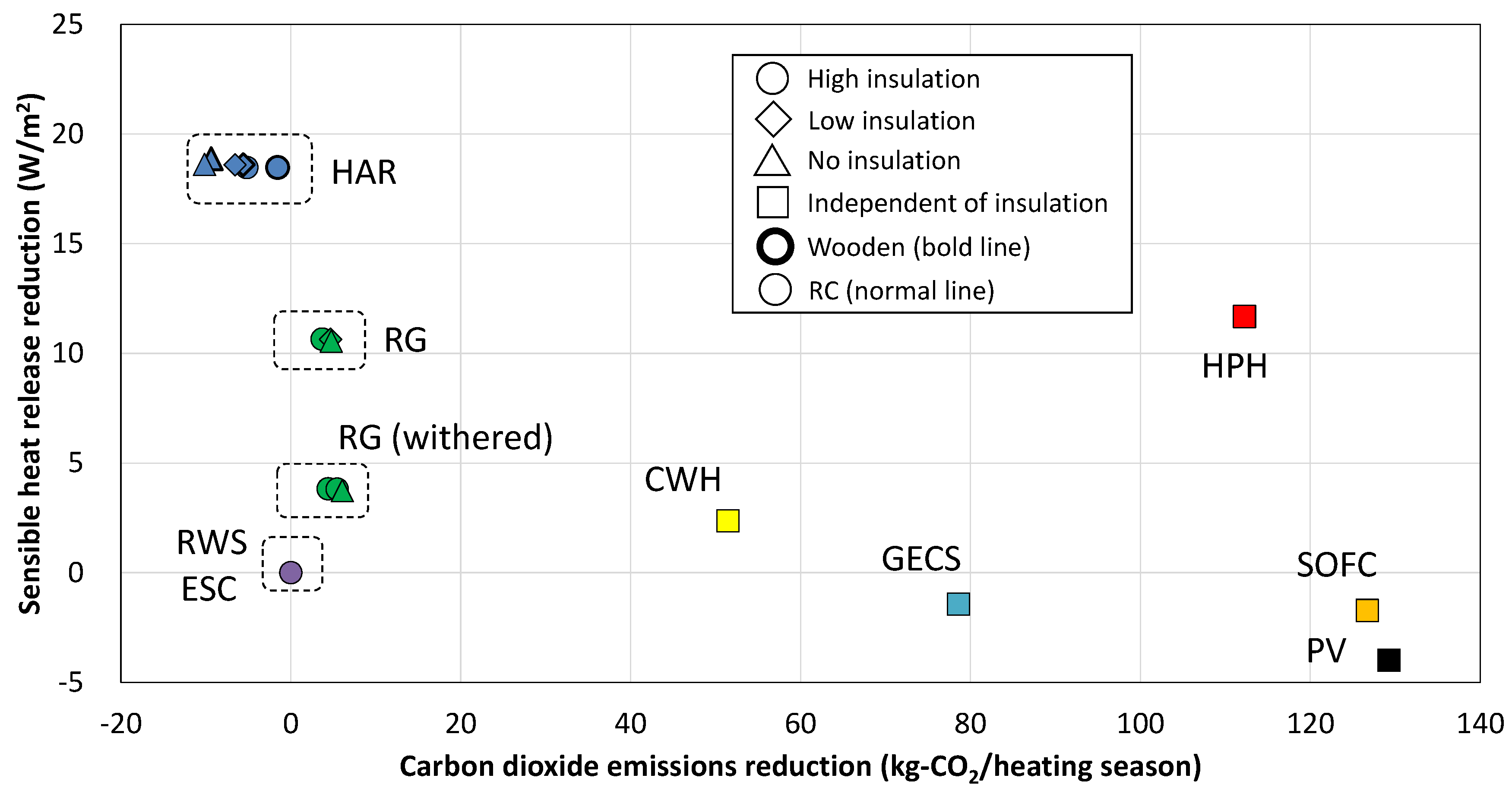
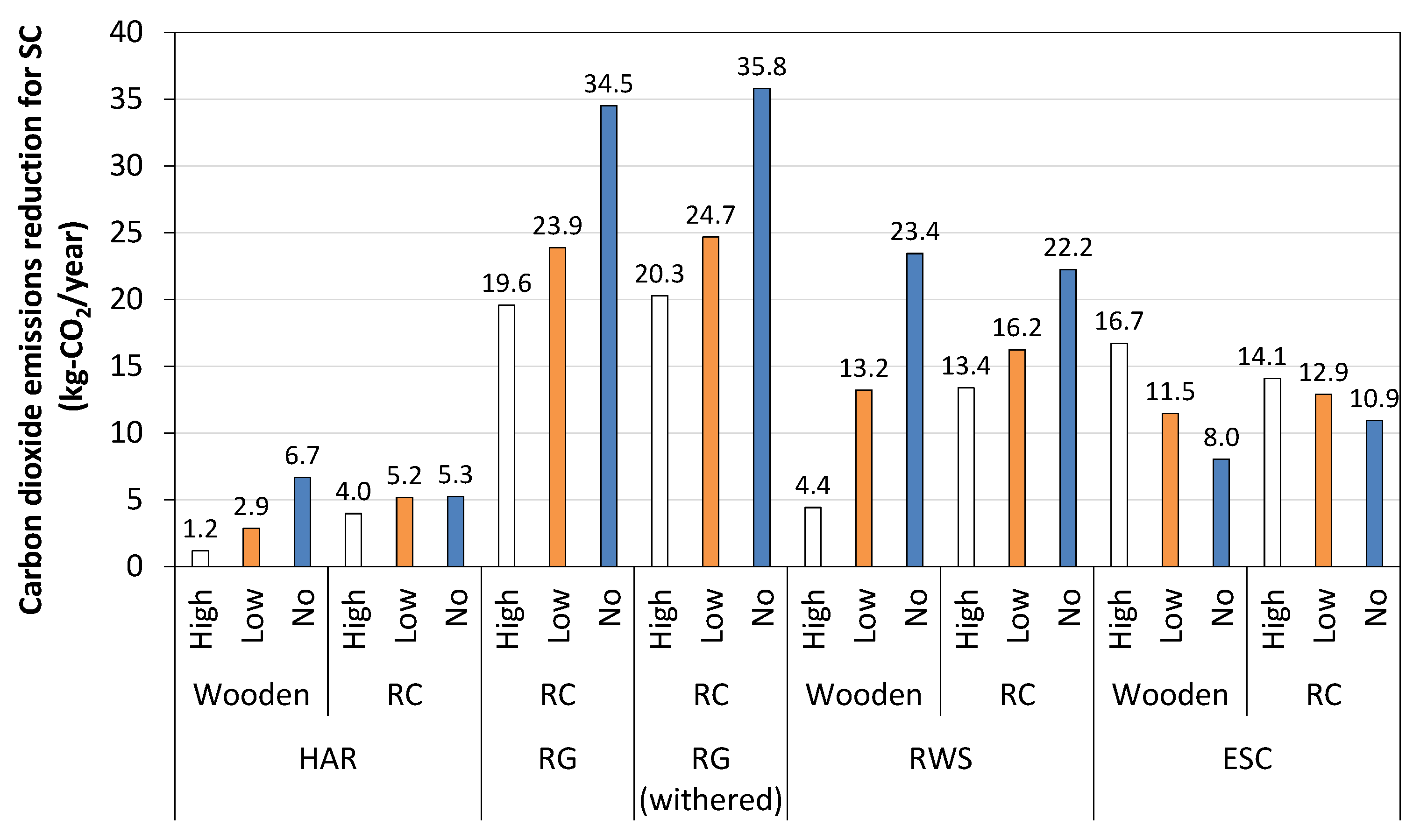
| Property | Value | |
|---|---|---|
| Outdoor | Climate condition | Expanded AMeDAS weather data [46]): standard year (Osaka city, Japan) |
| Ground albedo | 0.16 | |
| Building | House model | Standard residential house model [45] |
| Structure | Wooden or reinforced concrete | |
| Insulation | 3 levels: no = no insulation; low = insulation equivalent to the old 1980 Japanese energy-saving code; high = insulation equivalent to the next-generation 1999 Japanese energy-saving code | |
| Envelope albedo | 0.20 (base condition) | |
| Space conditioning unit | Air-cooled type heat pumps; cooling capacity in living room, main bedroom: each 3.6 kW; cooling capacity in child bedrooms 1 and 2: each 2.2 kW | |
| Occupant | Household | Two adults (one employed outside the home, the other a homemaker) and two schoolchildren |
| Preset temp. and relative humidity | 27 °C and 60% RH in the cooling season; 22 °C and uncontrolled humidity in the heating season | |
| Opening pattern | Determined by the indoor climate control behavior model [39] depending on the weather conditions | |
| Schedule of occupancy and heat generation | Set by applying the automatic setup scheduling program SCHEDULE [47] | |
| Part | Insulation Level | Wooden | |||
|---|---|---|---|---|---|
| Layer | Thermal Conductivity (W/m·K) | Volumetric Heat Capacity (kJ/m3·K) | Thickness (m) | ||
| Outer Wall | Common | Gypsum board | 2.14 × 10−1 | 8.54 × 102 | 1.2 × 10−2 |
| High | Insulator | 3.60 × 10−2 | 2.70 × 101 | 4.4 × 10−2 | |
| Low | 5.11 × 10−2 | 8.41 | 3.2 × 10−2 | ||
| High | Air layer | 7.00 × 10−2 * | 1.20 | 4.2 × 10−2 | |
| Low | 5.4 × 10−2 | ||||
| No | 8.6 × 10−2 | ||||
| Common | Plywood | 1.29 × 10−1 | 1.11 × 103 | 9.0 × 10−3 | |
| Common | Mortar | 1.09 | 2.31 × 103 | 3.0 × 10−2 | |
| Rooftop | Common | Gypsum board | 2.14 × 10−1 | 8.54 × 102 | 1.2 × 10−2 |
| High | Insulator | 3.60 × 10−2 | 2.70 × 101 | 4.4 × 10−2 | |
| Low | 5.11 × 10−2 | 8.41 | 3.2 × 10−2 | ||
| High | Air layer | 7.00 × 10−2 * | 1.20 | 4.2 × 10−2 | |
| Low | 5.4 × 10−2 | ||||
| No | 8.6 × 10−2 | ||||
| Common | Plywood | 1.29 × 10−1 | 1.11 × 103 | 1.2 × 10−2 | |
| Common | Slate | 9.63 × 10−1 | 1.52 × 103 | 1.2 × 10−2 | |
| Part | Insulation level | Reinforced concrete | |||
| Layer | Thermal conductivity (W/m·K) | Volumetric heat capacity (kJ/m3·K) | Thickness (m) | ||
| Outer Wall | Common | Gypsum board | 2.14 × 10−1 | 8.54 × 102 | 1.2 × 10−2 |
| High | Insulator | 3.60 × 10−2 | 2.70 × 101 | 4.4 × 10−2 | |
| Low | 5.11 × 10−2 | 8.41 | 3.2 × 10−2 | ||
| High | Air layer | 7.00 × 10−2 * | 1.20 | 4.2 × 10−2 | |
| Low | 5.4 × 10−2 | ||||
| No | 8.6 × 10−2 | ||||
| Common | Plywood | 1.29 × 10−1 | 1.11 × 103 | 9.0 × 10−2 | |
| Common | Mortar | 1.09 | 2.31 × 103 | 3.0 × 10−2 | |
| Rooftop | Common | Gypsum board | 2.14 × 10−1 | 8.54 × 102 | 1.2 × 10−2 |
| High | Insulator | 3.60 × 10−2 | 2.70 × 101 | 4.4 × 10−2 | |
| Low | 5.11 × 10−2 | 8.41 | 3.2 × 10−2 | ||
| High | Air layer | 7.00 × 10−2 * | 1.20 | 4.2 × 10−2 | |
| Low | 5.4 × 10−2 | ||||
| No | 8.6 × 10−2 | ||||
| Common | Plywood | 1.29 × 10−1 | 1.11 × 103 | 1.2 × 10−2 | |
| Common | Slate | 9.63 × 10−1 | 1.52 × 103 | 1.2 × 10−2 | |
| Countermeasure | Main Target | Computational Condition |
|---|---|---|
| High-albedo roof (HAR) | UHIE | Raising the rooftop albedo to 0.60 from 0.20 |
| Roof greening (RG) | UHIE | Improving evaporation efficiency of the rooftop to 0.3 from 0.0 and albedo of the rooftop to 0.25 Adding a greening and soil layer on rooftop surface Setting for the reinforced concrete structure only Setting the condition for withering during winter |
| Roof water showering (RWS) | UHIE | ·Setting evaporation efficiency of rooftop to 0.7 from 0.0 when the rooftop surface temperature exceeds 40 °C in the daytime until 5 p.m. Evaporation efficiency will gradually decrease in the nighttime |
| Evaporative space cooling (ESC) | UHIE | Improving indoor thermal comfort by spraying dry fog jet Cooling effect is equivalent to 1 K decrease in SET * Jetting will be stopped when behavior model judges AC is required Installing only in the air-conditioned room—9 nozzles each in the living room and the main bedroom, and 4 nozzles each in the child bedrooms The amount of water used per nozzle was 1.34 L per minute (L/min) |
| Condensing water heater (CWH) | GW | Improving the efficiency to 95% from 78% |
| Heat pump water heater (HPH) | GW | Setting rated generation output of the hot water at 4.5 kW Improving the efficiency Absorbing heat from the ambient atmosphere Changing the COP due to outside air temperature |
| Gas engine cogeneration system (GECS) | GW | Setting rated power generation output at 1.0 kW and rated power generation efficiency at 20% Heat exhaust efficiency at 57% Operating in accordance with the heat demand Number of operations per day is unlimited but excessive start/stop is restricted |
| Solid oxide fuel cell (SOFC) | GW | Setting rated power generation output at 0.7 kW and rated power generation efficiency at 45% Heat exhaust efficiency at 36% (depend on the load) Setting hourly power generation as for fitting electricity load without start/stop |
| Photovoltaic power generation (PV) | GW | Setting rated power generation efficiency at 13% Considering the influence of decreasing the albedo on the rising temperature of the rooftop surface and increasing heat release |
Publisher’s Note: MDPI stays neutral with regard to jurisdictional claims in published maps and institutional affiliations. |
© 2021 by the authors. Licensee MDPI, Basel, Switzerland. This article is an open access article distributed under the terms and conditions of the Creative Commons Attribution (CC BY) license (https://creativecommons.org/licenses/by/4.0/).
Share and Cite
Narumi, D.; Levinson, R.; Shimoda, Y. Effect of Urban Heat Island and Global Warming Countermeasures on Heat Release and Carbon Dioxide Emissions from a Detached House. Atmosphere 2021, 12, 572. https://doi.org/10.3390/atmos12050572
Narumi D, Levinson R, Shimoda Y. Effect of Urban Heat Island and Global Warming Countermeasures on Heat Release and Carbon Dioxide Emissions from a Detached House. Atmosphere. 2021; 12(5):572. https://doi.org/10.3390/atmos12050572
Chicago/Turabian StyleNarumi, Daisuke, Ronnen Levinson, and Yoshiyuki Shimoda. 2021. "Effect of Urban Heat Island and Global Warming Countermeasures on Heat Release and Carbon Dioxide Emissions from a Detached House" Atmosphere 12, no. 5: 572. https://doi.org/10.3390/atmos12050572
APA StyleNarumi, D., Levinson, R., & Shimoda, Y. (2021). Effect of Urban Heat Island and Global Warming Countermeasures on Heat Release and Carbon Dioxide Emissions from a Detached House. Atmosphere, 12(5), 572. https://doi.org/10.3390/atmos12050572






